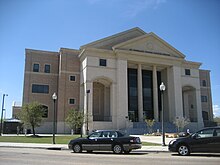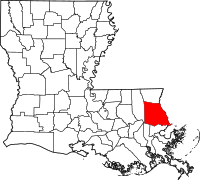St. Tammany Parish
| Saint Tammany Parish, Louisiana | |
|---|---|

St. Tammany Parish Justice Center
|
|
 Location in the U.S. state of Louisiana |
|
 Louisiana's location in the U.S. |
|
| Founded | October 27, 1810 |
| Named for | Indian Chief Tamanend |
| Seat | Covington |
| Largest city | Slidell |
| Area | |
| • Total | 1,124 sq mi (2,911 km2) |
| • Land | 846 sq mi (2,191 km2) |
| • Water | 279 sq mi (723 km2), 25% |
| Population (est.) | |
| • (2015) | 250,088 |
| • Density | 290/sq mi (112/km²) |
| Congressional district | 1st |
| Time zone | Central: UTC-6/-5 |
| Website | www |
St. Tammany Parish (French: Paroisse de Saint-Tammany) is a parish located in the U.S. state of Louisiana. As of the 2010 census, the population was 233,740, making it the fifth-most populous parish in Louisiana. The parish seat is Covington. The parish was founded in 1810.
St. Tammany Parish is included in the New Orleans–Metairie, LA Metropolitan Statistical Area. St. Tammany Parish is one of the fastest-growing parishes in the state, along with Livingston and Ascension.
St. Tammany Parish is colloquially referred to as part of the "Northshore" or "North Shore" throughout metropolitan New Orleans, owing to its location on Lake Pontchartrain. It is the most affluent parish in the state, has a nationally-recognized system of public schools, and is the most politically conservative parish in the New Orleans region.
The Moon Handbooks: New Orleans, Including Cajun Country and the River Road, published in 2007, stated that people wanting to live in proximity to New Orleans without living in New Orleans will probably cause the population of St. Tammany Parish to increase.
In 1699, Pierre Le Moyne d'Iberville, a French explorer, was the first European to visit the area of present-day St. Tammany Parish. While exploring lakes Pontchartrain and Maurepas, Iberville wrote in his journal, "The place where I am is one of the prettiest I have seen, fine level ground bare of canes. The land north of the lakes is a country of pine trees mixed with hard woods. The soil is sandy and many tracks of buffalo and deer can be seen."
...
Wikipedia
